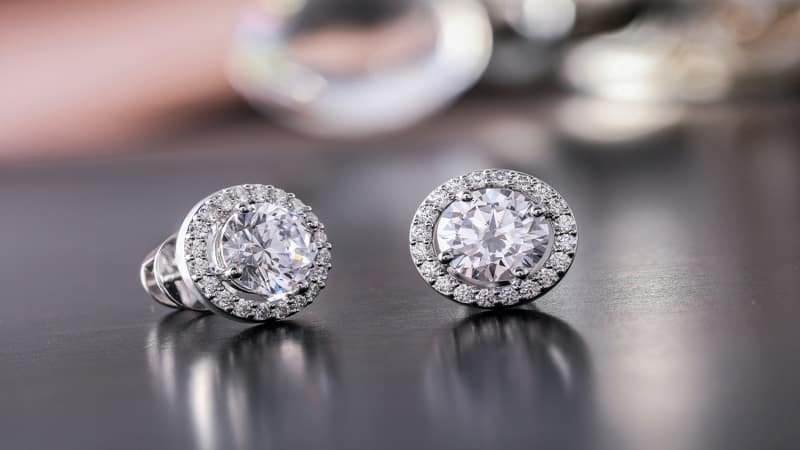How to Tell If Platinum Is Real

There is no denying that purchasing jewelry is not an easy task anymore. With the number of fraudulent sellers and high-quality artificial jewelry being made to mimic precious metals and stones, one must be extremely cautious while buying jewelry.
This is the reason why many of us are already aware of being swindled through fool’s gold. A yellow, shining substance, also known as iron pyrite, is made to mimic the smooth, shiny surface of yellow gold, which has confused many gold seekers. But are you aware of fake platinum? You don’t want to make a high-magnitude purchase of platinum to find out it is silver or, worse, steel!
Platinum is already very difficult to tell apart from silver and other silver-colored metals. Therefore, it is a challenging precious metal to purchase, given how easy it is to get fooled by something fake instead of valuable platinum. Hence, below we share our foolproof rules to identify if platinum is real to help you recognize the precious metal when you see it.
Rule # 1 Verify the Source
First and most importantly, always verify your source of the precious metal or jewelry you are purchasing. It is essential to deal with a reliable and trustworthy dealer that has credible references to its name. In fact, it is even better if you make such valuable purchases for a long-term family lineage jeweler. This way, chances are low that they would indulge in any fraudulent activity with you.
Rule # 2 Visual Inspection
One of the best ways to tell if platinum is real or fake is to do a thorough visual inspection. The reason is that many forms of platinum, because the precious metal is so valuable, carry markings. These stamped markings of the acronym PT, PLAT denoting platinum are engraved upon the metal or even jewelry pieces. This allows clear identification that you have at least 95% pure platinum jewelry on your hands. In addition to this, other visual indicators appear to the naked eye if looked closely enough, like:
- A distinct brighter white color that is different from white gold or silver.
- Minor scratches because, contrary to popular belief, platinumis scratch resistant and not guaranteed scratch proof.
- Absolutely no signs of tarnishing because, just like gold, platinumdoesn’t rust or corrode.
- No signs of discoloration because pure and real platinumwouldn’t typically lose its color.
- A heavier and dense surface when placed on your palm.
Moreover, it is important to remember that platinum manufacturing is slightly different from pure platinum or any platinum jewelry piece readily available. For instance, if your metal feels softer, it may be platinum-iridium used as an alloy. It is not uncommon to mix platinum with another type of substance to create alloys because platinum alloys are easier to work with. Hence, there might be a percentage of platinum in it, but it isn’t pure platinum.
Rule # 3 Platinum vs. Silver
Chances are that if a precious metal dealer is looking to exploit you, they would charge you for platinum but sell you silver. For naïve buyers who cannot tell platinum and silver apart, this trick works great for swindlers. Therefore it is important to be able to recognize the difference between platinum and silver because it isn’t completely indistinguishable after all. Furthermore, silver is much common metal in use compared to platinum. So if you have trouble detecting platinum, teach your keen eyes to observe the properties of silver instead.
Silver is softer, allowing you to scratch the surface.
You can bite the metal hard, and if you see tooth marks, it is silver.
Silver has a lighter density clearly noticeable when placed on the palm.
Rule # 4 No Price Bargain
Make it a steadfast rule to never trust any precious metal jewelry or ornament being sold to you for a lesser price than usual. Make sure to check the market rates of the metal you are going to purchase, whether gold, platinum, or silver, and even white gold. If your precious metals dealer tries to sell you a product for a price nearer to white god than platinum, then the chances are that’s what is being sold to you. Many people get forged into such a tactic due to the price reduction, but you have to stay alert and notified of any suspicious price tag.
Rule # 5 Conduct Tests
It isn’t easy to buy precious metal and be able to conduct a method of tests to verify its originality. However, if you do get a chance, it is one of the best ways to tell if your platinum is real or fake.
® Magnet Test
Use a simple magnet and try to stick it to your metal. Platinum isn’t magnetic at all. So if you do feel a slight pull, it isn’t real platinum but white gold that is too mixed with nickel that makes it attractive to the magnet.
® Acid Scratch Test
Firstly observe if your piece of metal has any markings. If there are no clearly visible markings, then purchase an acid scratch test kit that you should easily find online. The kit should provide you with a scratch stone and types of different acid solutions. You can complete the test as per instructions, which should indicate if you have real platinum, platinum alloy, or white gold at your hands.
Our Final Thoughts
Platinum is an extremely precious metal. Going about seeking pure platinum without proper knowledge and understanding is fool’s play. Therefore, now that you know the five main rules of identifying if your platinum is real or fake, it should help you make valuable purchases easier than before.